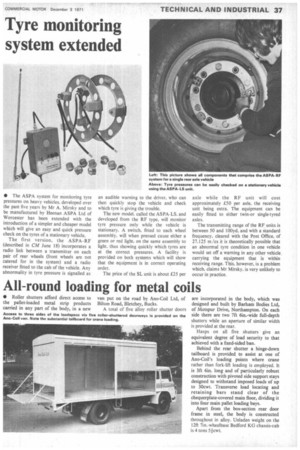Tyre monitoring system extended
Page 39

If you've noticed an error in this article please click here to report it so we can fix it.
• The ASPA system for monitoring tyre pressures on heavy vehicles, developed over the past five years by Mr A. Mirsky and to be manufactured by Heenan ASPA Ltd of Worcester has been extended with the introduction of a simpler and cheaper model which will give an easy and quick pressure check on the tyres of a stationary vehicle.
The first version. the ASPA-RF (described in CM June 18) incorporates a radio link between a transmitter on each pair of rear wheels (front wheels are not catered for in the system) and a radio receiver fitted to the cab of the vehicle. Any abnormality in tyre pressure is signalled as an audible warning to the driver, who can then quickly stop the vehicle and check which tyre is giving the trouble.
The new model, called the ASPA-LS. and developed from the RF type. will monitor tyre pressure only while the vehicle is stationary. A switch, fitted to each wheel assembly. will when pressed cause either a green or red light, on the same assembly to light, thus showing quickly which tyres are at the correct pressures. A facility is provided on both systems which will show that the equipment is in correct operating order.
The price of the SL unit is about £25 per axle while the RF unit will cost approximately £50 per axle, the receiving unit being extra. The equipment can be easily fitted to either twin-or single-tyred axles.
The transmitting range of the RF units is between 50 and 100yd. and with a standard frequency, cleared with the Post Office, of 27.125 m ics it is theoretically possible that an abnormal tyre condition in one vehicle would set off a warning in any other vehicle, carrying the equipment that is within receiving range. This, however, is a problem which. claims Mr Mirsky, is very unlikely to occur in practice.


































































































































